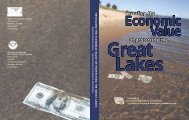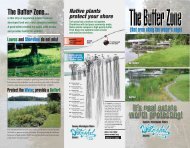Slope Stabilization Work Plan For Poplar River Management Board
Slope Stabilization Work Plan For Poplar River Management Board
Slope Stabilization Work Plan For Poplar River Management Board
Create successful ePaper yourself
Turn your PDF publications into a flip-book with our unique Google optimized e-Paper software.
<strong>Slope</strong> <strong>Stabilization</strong> <strong>Work</strong> <strong>Plan</strong><br />
North American Wetland Engineering, LLC.<br />
January 18, 2007 4444 Centerville Rd, Suite 140<br />
<strong>Poplar</strong> <strong>River</strong> <strong>Management</strong> <strong>Board</strong> White Bear Lake, MN 55127<br />
Phone: 651-255-5050<br />
Fax: 651-255-5060<br />
N<br />
Megaslump area<br />
Subwatershed Area<br />
~ 7.3 acres<br />
Figure 4.1: Subwatershed Area above the Megaslump<br />
The access road that begins at the southeast corner of the Caribou Highlands lagoon has ditches<br />
that provide drainage for the road and for the sideslopes of the lagoon. These ditches could be<br />
utilized to help drain the entire area above the megaslump. To determine the drainage options,<br />
additional survey data is needed.<br />
4.2 Potential Causes<br />
Free-flowing streams, where stream banks are unconfined by natural or anthropogenic structures,<br />
tend to establish a state of equilibrium. By this equilibrium, erosion at one location is roughly<br />
balanced by deposition at another. Even streams whose channels appear to be stable and welldefined<br />
will tend to adjust dynamically over extended time periods. In a state of equilibrium, the<br />
erosion and sedimentation process can help to maintain beneficial aquatic ecosystem structures,<br />
such as gravel beds that sometimes support fish spawning habitat. Likewise, dynamic fluvial<br />
processes will tend to establish series of pools, riffles and runs that provide aquatic habitat.<br />
(Connecticut <strong>River</strong> Joint Commission, 1996)<br />
Natural erosion and slope movement along stream channels is a dynamic process that provides<br />
sediment to the system based on many variables, including rainfall, soil properties and<br />
vegetation. As a result, natural systems under equilibrium may receive acute inputs of sediment<br />
from slope movements. Such movements may be rather small in scale, providing a plume of<br />
sediment that is conveyed downstream until a new equilibrium is attained. Conversely, large<br />
slope movements into the channel may be of sufficient mass to cause channel migration, thereby<br />
25







